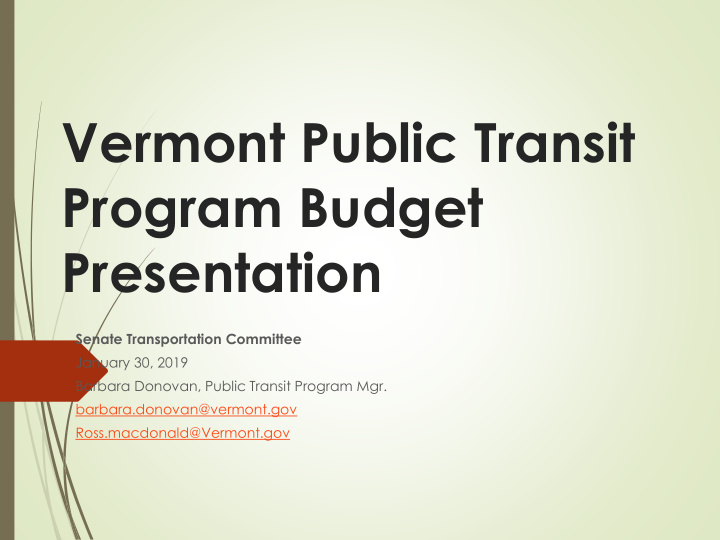



Vermont Public Transit Program Budget Presentation Senate Transportation Committee January 30, 2019 Barbara Donovan, Public Transit Program Mgr. barbara.donovan@vermont.gov Ross.macdonald@Vermont.gov
Public Transportation Organizational Chart Barbara Donovan Program Manager Amy Rast Tim Bradshaw Ross MacDonald Susan Bailey Public Transit Public Transit Public Transit Financial Coordinator Coordinator Coordinator Administrator Go Vermont
Transit in Vermont 625 employees in public transit in Vermont $19,000,000 in transit payroll in Vermont Approximately 420 buses in 2018 Replacement value of buses is $ 80 ,000,000 7 0% of buses are in good – excellent condition (FY18) 8 providers Approximately 16,100 riders/day 255 municipalities served 15 facilities
State Strategic Goals Growing the Vermont Economy Making Vermont an affordable place to live, work, and do business Protecting vulnerable Vermonters
Vermont has a variety of Public Transit modes that serve the state: urban fixed route buses commuter routes rural daily or weekly services that are either fixed route or have deviation options demand response (pick up and drop off as needed usually at home and at destinations) intercity and intercity feeder service Go Vermont, vanpools, carpools and travel information Various IT systems and services to provide information and access to services
Ski area transit In-Town Transit Express Commuter Runs Vermont Shires Connector College area bus City Routes
Public Transit 2020 – Governor’s Recommend – Transportation Program Project Other T-Fund Federal Total Administrative Support $ 727,514 $ 41,198 $ 686,316 $ 727,514 Capital – General Public $8,371,737 $ 824,913 $7,546,824 $8,371,737 Capital – E&D $ 625,000 $ 125,000 $ 500,000 $ 625,000 Capital – Facility $ 800,000 $ 50,000 $ 750,000 $ 800,000 Capital Commuters $ 100,000 $ 100,000 $ 0.00 $ 100,000 CMAQ - Expansion $3,307,122 $ 305,000 $3,002,122 $3,307,122 Older Vermonters and $4,102,000 $ 102,000 $4,000,000 $4,102,000 Persons with Disabilities Expanded Barre Transit $ 275,000 $ 55,000 $ 220,000 $ 275,000 Go Vermont $ 858,434 $ 60,000 $ 798,434 $ 858,434 Maintenance Assistance $4,327,368 $ 0.00 $4,327,368 $4,327,368 Opioid Treatment Pilot $ 200,000 $ 200,000 $ 0.00 $ 200,000 Planning FTA $ 145,200 $ 28,000 $ 117,200 $ 145,200 Reserve E&D $ 200,000 $ 40,000 $ 160,000 $ 200,000 RTAP $ 110,000 $ 0.00 $ 110,000 $ 110,000 Transit Administrative $2,900,000 $ 0.00 $2,900,000 $2,900,000 Transit Operations $6,100,000 $6,100,000 $ 0.00 $6,100,000 Kidney Association $50,000 $50,000 $ 0.00 $50,000 Totals Public Transit $37,024,399 $8,256,111 $28,768,288 $37,024,399
Changes to the Public Transit Budget The only significant changes to the public transit budget were: A increase in Program Administration in order to change to 100% federal funding (with the exception of some which are not federally eligible) An Increase in Maintenance as we separate the administration from the maintenance expenses A decrease in capital commuters as we hopefully switch to a statewide system An increase in capital to account for competitive grants A new pilot project to address the auxiliary needs of those recovering from opioid addiction Otherwise just small increases to accommodate increased costs
Capital Needs - Vehicles, Facilities, Technology
Vehicles - Needs # of Vehicles Federal Cost $ 80% State Cost $ 10% Total Cost (wo local) FY19 38 $ 4,504,000 $ 563,000 $ 5,630,000 FY 20 70 $ 10,820,000 $ 1,352,500 $ 13,525,000 FY21 118 $ 15,412,000 $ 1,926,500 $ 19,265,000 FY22 35 $ 6,700,000 $ 837,500 $ 8,375,000 FY23 22 $ 5,100,000 $ 637,500 $ 6,375,000 FY24 13 $ 3,500,000 $ 437,500 $ 4,375,000 FY25 9 $ 3,180,000 $ 397,500 $ 3,975,000 FY26 5 $ 1,900,000 $ 237,500 $ 2,375,000 FY27 4 $ 1,520,000 $ 190,000 $ 1,900,000
Recommend
More recommend